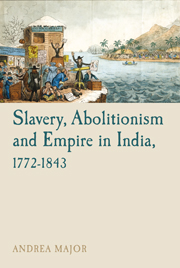Book contents
- Frontmatter
- Contents
- List of Illustrations
- Acknowledgements
- List of Abbreviations
- Glossary
- Some Prominent Figures in the British Parliament, the Abolitionist Movement and the East India Company
- Part I Other Slaveries
- Part II European Slaveries
- Part III Indian Slaveries
- Part IV Imagined Slaveries
- Introduction: Evangelical Connections
- 7 ‘Satan's Wretched Slaves’: Indian Society and the Evangelical Imagination
- 8 ‘The Produce of the East by Free Men’: Indian Sugar and Indian Slavery in British Abolitionist Debates, 1793–1833
- Conclusion: ‘Do Justice to India’: Abolitionists and Indian Slavery, 1839–1843
- Select Bibliography
- Index
8 - ‘The Produce of the East by Free Men’: Indian Sugar and Indian Slavery in British Abolitionist Debates, 1793–1833
from Part IV - Imagined Slaveries
- Frontmatter
- Contents
- List of Illustrations
- Acknowledgements
- List of Abbreviations
- Glossary
- Some Prominent Figures in the British Parliament, the Abolitionist Movement and the East India Company
- Part I Other Slaveries
- Part II European Slaveries
- Part III Indian Slaveries
- Part IV Imagined Slaveries
- Introduction: Evangelical Connections
- 7 ‘Satan's Wretched Slaves’: Indian Society and the Evangelical Imagination
- 8 ‘The Produce of the East by Free Men’: Indian Sugar and Indian Slavery in British Abolitionist Debates, 1793–1833
- Conclusion: ‘Do Justice to India’: Abolitionists and Indian Slavery, 1839–1843
- Select Bibliography
- Index
Summary
In 1829, George Saintsbury published a pamphlet entitled East India Slavery, in which he provided a shocking expose of ‘unfree labour’ in British India, declaring, ‘throughout India slavery prevails; India is therefore a slave territory, as Jamaica is a slave colony’. His ‘humanitarian’ efforts to awaken public sympathy for the sufferings of poor East Indian slaves met with a hostile response in the pages of the Anti-Slavery Monthly Reporter, however, for Saintsbury was not a campaigning philanthropist, missionary or abolitionist, but an active member of the West Indian Association. His exposé of Indian labour conditions was not designed to further the cause of universal ‘anti-slavery’ but rather to undermine emerging attempts on the part of abolitionists and East India commercial interests to position India as a ‘free-labour’ alternative to the West Indian slave system. To this end he used recently published East India Company records to demonstrate the existence of slavery in India and highlight the fortunate position of the ‘pampered Negro slave’ compared with that of the average poverty-stricken East Indian peasant. Given Saintsbury's obvious agenda, it is perhaps not surprising that the Anti-Slavery Monthly Reporter did not immediately rally to the cause of East Indian slaves, but rather attacked Saintsbury for ‘wilful and deliberate misrepresentation’ of the facts. On this occasion, as on others when the idea of ‘unfree’ labour in India intersected with abolitionist discourses, their treatment of the issue was ambivalent.
- Type
- Chapter
- Information
- Slavery, Abolitionism and Empire in India, 1772–1843 , pp. 293 - 320Publisher: Liverpool University PressPrint publication year: 2012



